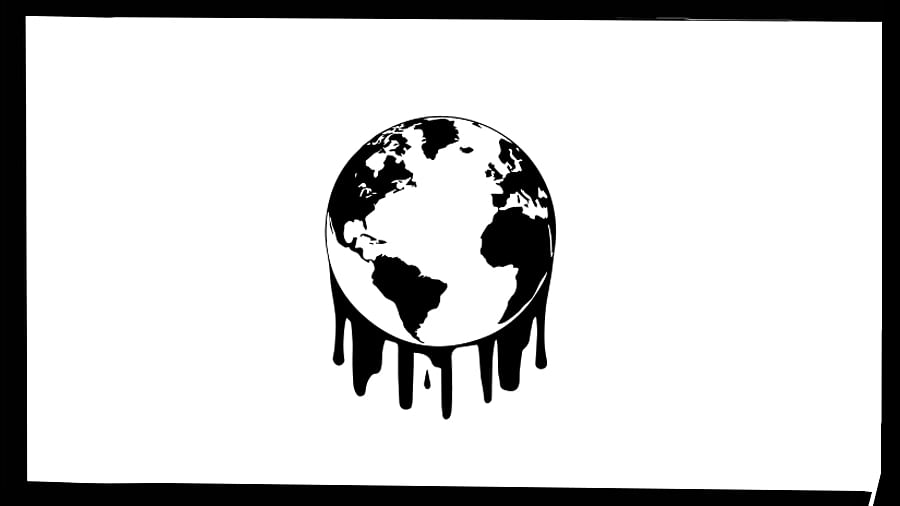
DH Illustration.
The International Panel on Climate Change (2014) predicted dramatic changes in climate patterns in the current century, and this will inevitably have significant adverse effects on agricultural production. When we juxtapose the global population increase with changes in ambient temperature, a grim scenario emerges. Current projections suggest that global temperature will rise by 1.8–4 degrees Celsius, and the corresponding global population increase might touch 10 billion by 2050—an increase of 142.9% from the current level of approximately 7 billion, which works to about an annual increase of 1.8%.
There are two kinds of greenhouse effects:
1. The natural greenhouse effect, which makes the ambient temperature of some high-altitude regions hospitable for life forms
2. The more common and extremely hazardous one, which occurs in the atmosphere due to emissions of industrial gases, such as CO2, and those from agricultural practices, like the excessive and unbridled use of nitrogen fertilisers, such as urea. This leads to a significant accumulation of nitrous oxide (N2O) in the troposphere, which is detrimental to both human habitation and plant life. Automobile emissions are an important contributor to the increased CO2 concentration in the atmosphere, which has risen from the pre-industrial level of 20 ppm (parts per million) to 40 ppm, a phenomenal 2,000% increase. However, what is even more concerning is the production of N2O, commonly known as laughing gas (dinitrogen monoxide), a major contributor to the depletion of stratospheric ozone and global warming. Nitrous oxide ranks third behind carbon dioxide and methane in its potency regarding global warming. It is 310 times more effective at trapping heat compared to CO2, with an average life span of 120 years. Approximately 30% of N2O in the atmosphere is attributed to agricultural practices, primarily the excessive use of nitrogenous fertilisers like urea.
The steep increase of N2O in the atmosphere coincided with the green revolution of the 1960s. When high food production is pursued through excessive use of nitrogen (N) fertilisers, such as urea, soil microbes convert N in the fertiliser urea into N2O at a faster rate than usual. This has been a major factor contributing to global warming, along with its associated adverse environmental consequences, including low precipitation, soil degradation, groundwater depletion, and more. Punjab, known as the “Cradle” of the Green Revolution, where thousands of acres of land have been irreparably damaged, serves as a vivid testament to this monumental environmental disaster.
In connection with climate change, despite numerous international meetings addressing the climate crisis,
it is essential to inform the reader
about important developments. The following summarises the facts on the climate front.
Developed countries are expected to exceed their carbon emissions targets for 2030 by a significant margin of 38%. According to the breakdown, the countries’ respective 2030 nationally determined contribution (NDC) targets and projected reductions are as follows:
The United States aimed for a 50% reduction, but its projected reduction is only 22%. Russia had a target of 70%, but projects a 48% reduction. Japan’s goal was 46%, and the projected reduction is 45%. The United Kingdom and Northern Ireland were targeting a 68% reduction, but they are projected to achieve only 56% reduction. Canada set a 40% reduction target, but its projected reduction is significantly lower at 30%. The European Union had a target of 55%, but its projected reduction stands at 44%. Kazakhstan aimed for a 15% reduction and comes close at a projected reduction of 14%.
It is worth noting that, based on this data, Japan and Kazakhstan are both on track to miss their emissions reduction targets by only one percentage point.
Developed countries responsible for three-fourths of current global carbon emissions will end up emitting 38% more carbon in 2030 than they have committed to, going by current trajectories, as shown in an investigation by a Delhi-based think tank, the Council for Energy, Environment, and Water (CEEW). The investigation, which precedes the 28th Conference of Parties (COP-28) of the United Nations Framework Convention on Climate Change (UNFCC) to be held in Dubai in November and December 2023, shows that 80% of this overshoot will be caused by the US, Russia, and the European Union. At COP28, countries are expected to give an account of their Nationally Determined Contributions (NDCs), which are their commitments to the UN emission cuts.
The CEEW investigation noted that the NDCs of developed countries already fall short of the global average reduction of emissions to 43% below 2019 levels that is needed to keep temperatures from rising above 1.5 degrees Celsius. Instead, the combined NDCs of developed countries only amount to a 36% cut.
For a fighting chance at keeping warming below critical tipping points, decades of negotiations have obliged developed countries to lead global efforts to reduce greenhouse gas emissions with legally binding targets. Collectively, developed countries were to reduce emissions by 5% from their 1990 levels between 2008 and 2012 and by 18% from 2013 to 2020.
While the countries mentioned above ostensibly kept their promises and cut emissions by 20%, it was not the result of any “planned exercise”; in fact, on the other hand, a significant chunk of the cuts were the result of the Covid-19 pandemic, which caused a global economic slowdown. This is what the CEEW researchers have conclusively shown.
Most developed countries appear to be planning to achieve their 2050 net zero targets by taking on deep emission cuts only after 2030, which, going by their own track record, seems overly ambitious. For instance, if all developed countries were to reach net zero by 2050, they would require more than a four-fold cut in the average annual reductions they had achieved between 1990 and 2020. Thus, the ostensibly “committed” emission reductions by all the developed countries and the actual ground reality will remain a pipe dream—in fact, a “political drama” like many others—far removed from reality.
(The writer is former Professor, the Royal Society, Belgium)